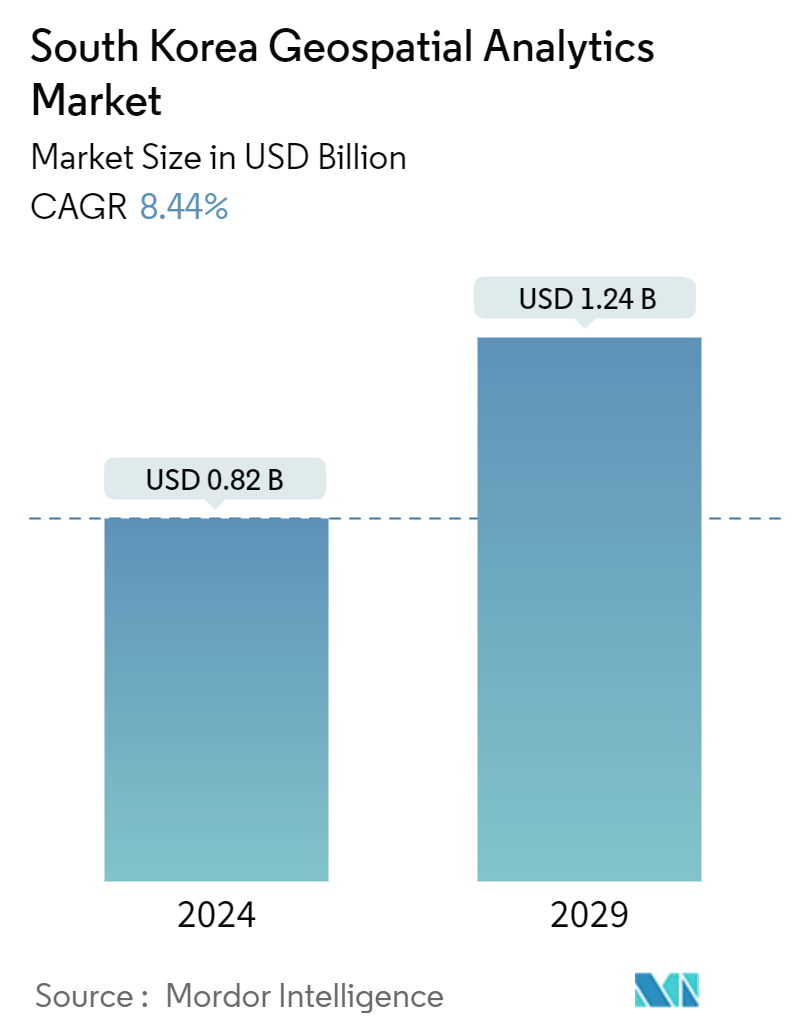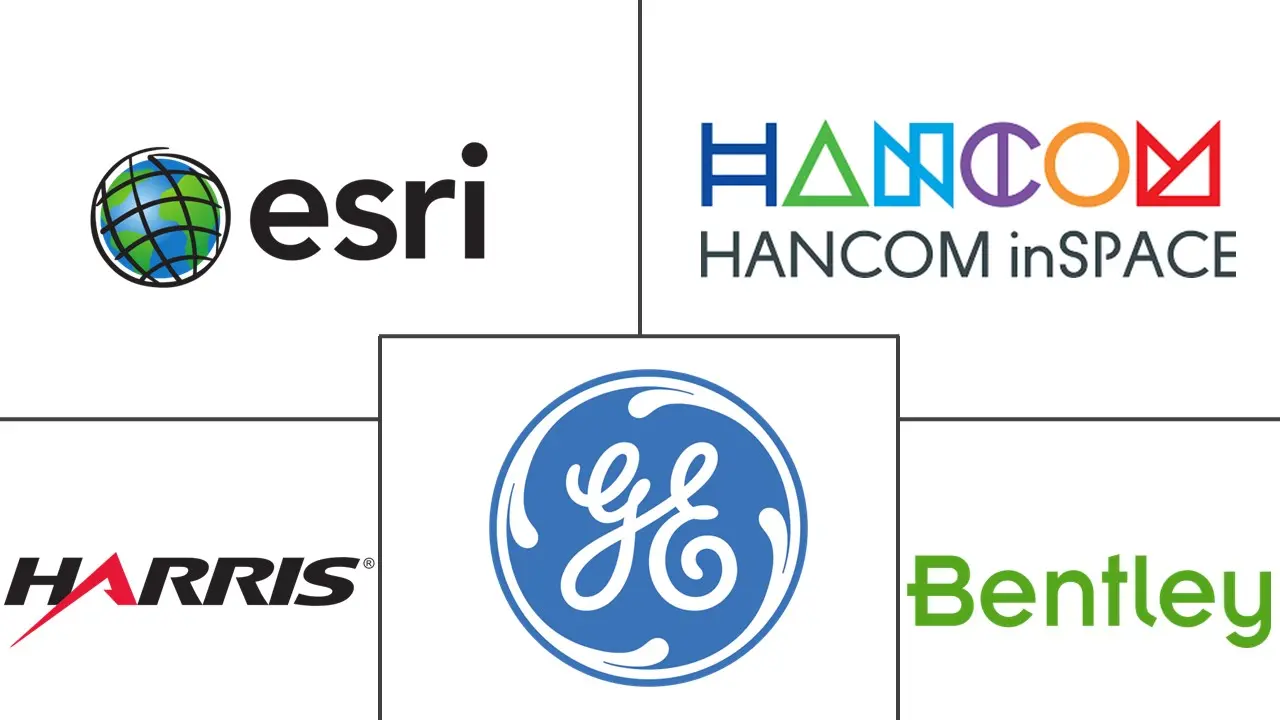Market Size of South Korea Geospatial Analytics Industry

| Study Period | 2019 - 2029 |
| Base Year For Estimation | 2023 |
| Market Size (2024) | USD 0.82 Billion |
| Market Size (2029) | USD 1.24 Billion |
| CAGR (2024 - 2029) | 8.44 % |
| Market Concentration | Medium |
Major Players
*Disclaimer: Major Players sorted in no particular order |
South Korea Geospatial Analytics Market Analysis
The South Korea Geospatial Analytics Market size is estimated at USD 0.82 billion in 2024, and is expected to reach USD 1.24 billion by 2029, growing at a CAGR of 8.44% during the forecast period (2024-2029).
South Korea has been experiencing an increasing demand for geospatial analytics due to the factors such as infrastructure development, including smart cities, transportation networks, and sustainable development.
- South Korea has highly developed urban areas with a dense population. Geospatial analytics assists in urban planning, land management, and real estate market analysis. It provides insights into population density, land value, infrastructure planning, and location-based services, driving the demand for geospatial analytics.
- The South Korean government has established various organizations and initiatives to drive geospatial analytics for urban planning. The Korean Land and Housing Corporation and the Ministry of Land Infrastructure and Transport (MOLIT) have also significantly implemented geospatial technologies and policies.
- Moreover, South Korea is prone to various natural disasters. Hence, the country is making various efforts to mitigate the risk. The Ministry of the Interior and Safety has been implementing a GIS-based integrated situation management system to convert disaster management into an electronic map-based.
- By utilizing geospatial data and analysis techniques, authorities and organizations can better understand and respond to natural disasters.
South Korea Geospatial Analytics Industry Segmentation
Geospatial analytics is the process of acquiring, manipulating, and displaying imagery and data from the geographic information system (GIS), such as satellite photos and GPS data. The specific identifiers of a street address and a zip code are used in geospatial data analytics. They are used to create geographic models and data visualizations for more accurate trends modeling and forecasting.
The South Korea geospatial analytics market is segmented by type (surface analysis, network analysis, geovisualization), end user vertical (agriculture, utility and communication, defence and intelligence, government, mining and natural resources, automotive and transportation, healthcare, real estate, and construction).
The market sizes and forecasts are provided in terms of value (USD) for all the above segments.
| By Type | |
| Surface Analysis | |
| Network Analysis | |
| Geo Visualization |
| By End-user Vertical | |
| Agriculture | |
| Utility and Communication | |
| Defense and Intelligence | |
| Government | |
| Mining and Natural Resources | |
| Automotive and Transportation | |
| Healthcare | |
| Real Estate and Construction | |
| Other End-user Verticals |
South Korea Geospatial Analytics Market Size Summary
The South Korea geospatial analytics market is poised for significant growth, driven by the country's focus on infrastructure development, smart cities, and sustainable urban planning. The increasing demand for geospatial analytics is fueled by the need for efficient urban planning, land management, and real estate market analysis in densely populated urban areas. The South Korean government, through organizations like the Korean Land and Housing Corporation and the Ministry of Land Infrastructure and Transport, is actively promoting the use of geospatial technologies to enhance urban planning and disaster management. These efforts are complemented by the country's initiatives to mitigate natural disaster risks using GIS-based systems, which integrate geospatial data for improved situational awareness and response.
In addition to urban development, geospatial analytics is playing a crucial role in South Korea's agricultural sector, where it is used to optimize agricultural practices and enhance productivity. By leveraging satellite imagery and aerial surveys, farmers can monitor crop health and manage resources more efficiently, supporting sustainable food production. The market is moderately consolidated, with key players like ESRI Inc., Soletop, and Bentley Systems, Inc. engaging in strategic partnerships and innovations to expand their offerings. These collaborations, such as the partnership between Yahana and Dabeeo, aim to enhance geospatial analytics capabilities, including AI-powered solutions for 3D mapping and traffic monitoring.
South Korea Geospatial Analytics Market Size - Table of Contents
-
1. MARKET INSIGHTS
-
1.1 Market Overview
-
1.2 Industry Attractiveness - Porter's Five Forces Analysis
-
1.2.1 Bargaining Power of Buyers
-
1.2.2 Bargaining Power of Suppliers
-
1.2.3 Threat of New Entrants
-
1.2.4 Threat of Substitutes
-
1.2.5 Intensity of Competitive Rivalry
-
-
1.3 Industry Value Chain Analysis
-
1.4 Assessment of the Impact of COVID-19 on the Market
-
-
2. MARKET SEGMENTATION
-
2.1 By Type
-
2.1.1 Surface Analysis
-
2.1.2 Network Analysis
-
2.1.3 Geo Visualization
-
-
2.2 By End-user Vertical
-
2.2.1 Agriculture
-
2.2.2 Utility and Communication
-
2.2.3 Defense and Intelligence
-
2.2.4 Government
-
2.2.5 Mining and Natural Resources
-
2.2.6 Automotive and Transportation
-
2.2.7 Healthcare
-
2.2.8 Real Estate and Construction
-
2.2.9 Other End-user Verticals
-
-
South Korea Geospatial Analytics Market Size FAQs
How big is the South Korea Geospatial Analytics Market?
The South Korea Geospatial Analytics Market size is expected to reach USD 0.82 billion in 2024 and grow at a CAGR of 8.44% to reach USD 1.24 billion by 2029.
What is the current South Korea Geospatial Analytics Market size?
In 2024, the South Korea Geospatial Analytics Market size is expected to reach USD 0.82 billion.

